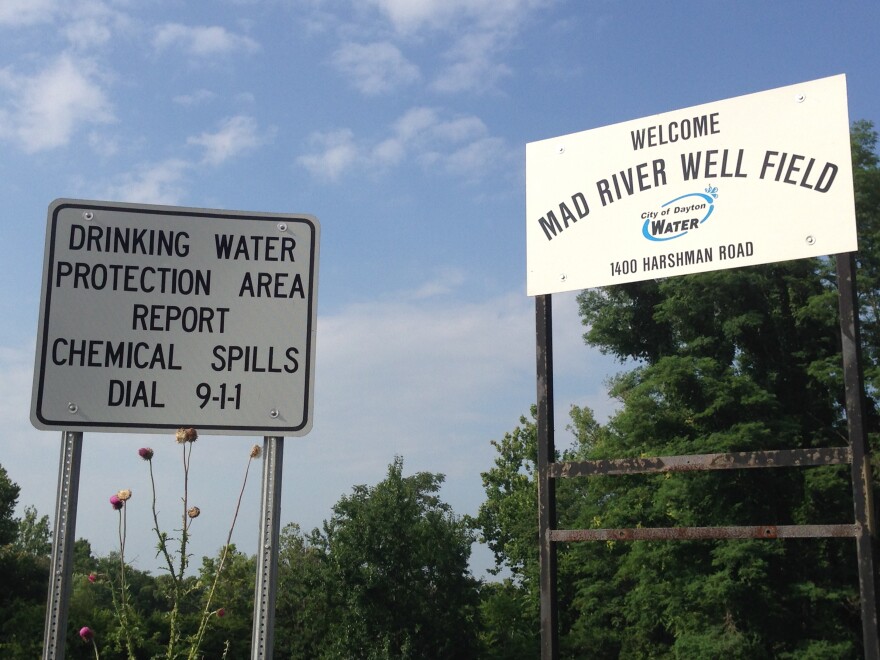The first of two public hearings is taking place Monday, July 14 on possible changes to Dayton’s drinking water protection program. Drinking water for more than 400,000 people in Montgomery and parts of Greene County comes from two wellfields that tap into the Great Miami Buried Valley Aquifer, a shallow sand and gravel aquifer that is vulnerable to contamination from surface spills. Currently Dayton has a program set up to limit potentially hazardous chemicals from areas above and near that water supply.
The protection area was first put in place to cover a one-year time of travel based on hydrologic modeling, meaning a chemical spilled within the area could reach drinking water supplies in a year or less. Michele Simmons, who’s Dayton’s environmental manager for water, says the city is ready to update its 26-year-old policy based on new information about water flow.
“We want to be protective of our aquifer, and we want to be responsive to our businesses who ask us, why are you regulating me?” Simmons says. She says demand on the city’s wells is down more than 25 percent since 2007, and the new one-year area is determined based on that current and projected reduction in demand, which in turns affects the speed of water flow into the area. The new proposal would reduce the area that is stringently protected by 40 percent, but increase the list of chemicals and practices forbidden within that area, newly blocking injection wells, open salt piles and chlorinated compounds, among other things.
The reduction in the area to be protected would decrease the total number of pounds of potentially hazardous chemicals considered a drinking water risk from 129 million to 5.8 million.
While some business owners have been pushing for relaxed regulations, not everyone is happy with the proposed changes. Dusty Hall, a long-time environmental advocate who was a leader in developing the original policy in the late 80s, says a one-year time of travel can be a fairly arbitrary line, and adds that there are lots of unknowns—for example, while stationary companies might be spilling and dumping less than they did a few decades ago, there are still transportation spills and other accidents.
“There can be lightning strikes, there can be tornadoes, there can be all kinds of things...and then the drama associated with those is directly proportional to the sensitivity of their locations,” Hall says.
He agrees the boundaries of the protection area could be updated. “The question is should they shrink or should they get bigger based on what we’ve learned, and in my experience I certainly would say it doesn’t make sense to shrink the boundaries at this point in the history of the program.” Hall sits on the City of Dayton’s Environmental Advisory Board but was not speaking to WYSO on behalf of that board.
The city's department of environmental management developed the changes and has already held a series of meetings with business owners, who Simmons says have given mixed feedback on the proposal. It would be the first major change in the area covered by the drinking water protections since they were created in 1988.
The Dayton area moved to create a strong source water policy after a Sherwin Williams paint warehouse caught fire and burned for days over a wellfield; firefighters couldn’t douse the fire with water for fear of contaminating the city’s wells, which had already been found to have elevated levels of potentially toxic chemicals due to industrial accidents over the aquifer. The city’s program was an innovative combination of limiting chemical inventories and funding a buy-down program to assist corporations already stocking those chemicals within the newly protected area.
Two public meetings for Dayton water customers will be held Monday, July 14 from 10am-12pm and Monday July 21 from 6pm-8pm in the Dayton City Commission chambers, 101 W. Third St., 2nd floor. Contact Dayton’s water department at 333-3725 for more information.
WYSO is focusing on water this month—tune in to Morning Edition Mondays for on-air updates. Lewis Wallace is WYSO's economics reporter and substitute morning host. Follow him @lewispants.


